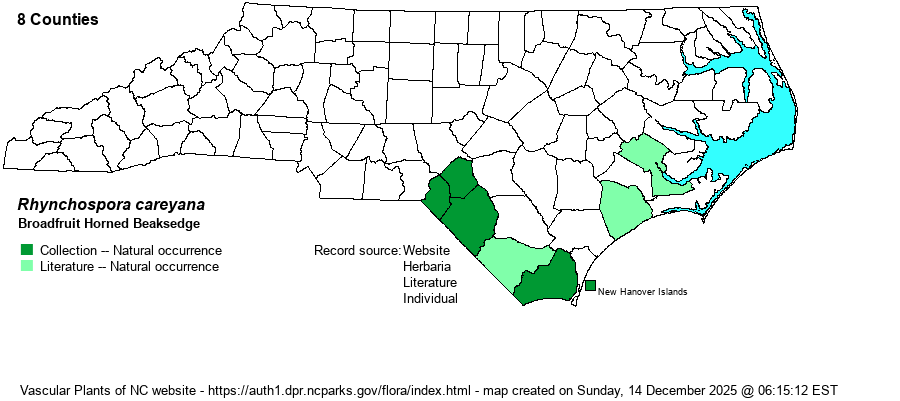| Author | Fernald | |
| Distribution | Southern portion of the outer and middle Coastal Plain, north conclusively to Hoke County. Absent from the Sandhills proper. The NCNHP Rare Plant List (2021) lists it as reported from Craven and Onslow counties, well north of where documented with specimens (i.e., Brunswick County). Positive identification versus R. inundata is needed.
Coasta Plain, NC to southern FL to southeastern LA; disjunct to southern DE. Cuba, Jamaica. | |
| Abundance | Rare to locally uncommon. Usually common where found, even abundant. However, it prefers high-water cycles and may not appear during droughts. This is a Watch List species. | |
| Habitat | Clay-based Carolina bays, limesink and other depression ponds, interdune depression ponds (Carolina Beach State Park). |
| Phenology | Flowering and fruiting July-September. | |
| Identification | This is one of our most robust beaksedges, in favorable years (i.e., high water) culms grow 3-5 feet tall and leaves about 3 feet long. It grows from long horizontal rhizomes, thus forming loose colonies. The inflorescence is very broad and very open; spikelets are orange-brownish and with a long beak. R. inundata can be told with certainty by its much longer seed bristles (extending twice the length of the seed body vs. generally the same length as the body in R. careyana). | |
| Taxonomic Comments | None
Members of the genus Rhynchospora -- mainly called beaksedges but also called beakrushes -- are mostly Coastal Plain in distribution and are important members of our longleaf pine savannas, flatwoods, streamheads, depression ponds, Carolina bays, and beaver ponds. They vary from small and wiry to large and coarse. Keys concentrate on features of the achenes (seeds) and the shape and arrangement of the flower clusters (spikelets). The seeds may or not have bristles at their base; bristle number, length, and toothing are critical characters. Size and shape of the seed beaks is also critical. The drawings in Godfrey & Wooten (1979) are extremely helpful. The genus now includes Dichromena, the white-topped sedges. | |
| Other Common Name(s) | Carey's Horned Beaksedge | |
| State Rank | S2 | |
| Global Rank | G4?Q | |
| State Status | W1 | |
| US Status | | |
| USACE-agcp | OBL link |
| USACE-emp | OBL link |

